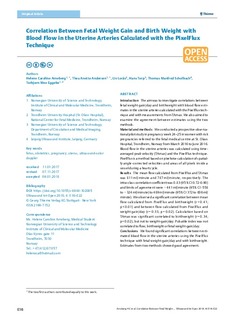| dc.contributor.author | Arneberg, Helene Caroline | |
| dc.contributor.author | Andersen, Thea Anette | |
| dc.contributor.author | Lorås, Liv | |
| dc.contributor.author | Torp, Hans | |
| dc.contributor.author | Scholbach, Thomas | |
| dc.contributor.author | Eggebø, Torbjørn Moe | |
| dc.date.accessioned | 2018-09-27T09:07:57Z | |
| dc.date.available | 2018-09-27T09:07:57Z | |
| dc.date.created | 2018-09-24T16:18:57Z | |
| dc.date.issued | 2018 | |
| dc.identifier.citation | OpenAccess Series in Informatics. 2018, 4 E16-E22. | nb_NO |
| dc.identifier.issn | 2190-6807 | |
| dc.identifier.uri | http://hdl.handle.net/11250/2564888 | |
| dc.description.abstract | Introduction The aim was to investigate correlations between fetal weight gain/day and birthweight with blood flow estimates in the uterine arteries calculated with the PixelFlux technique and with measurements from TAmax. We also aimed to examine the agreement between estimates using the two methods.
Material and methods We conducted a prospective observational pilot study in pregnancy week 24–25 in women with risk pregnancies referred to the fetal medical centre at St. Olavs Hospital, Trondheim, Norway from March 2016 to June 2016. Blood flow in the uterine arteries was calculated using time-averaged peak velocity (TAmax) and the PixelFlux technique. PixelFlux is a method based on pixelwise calculation of spatially angle-corrected velocities and areas of all pixels inside a vessel during a heart cycle.
Results The mean flow calculated from PixelFlux and TAmax was 811 ml/minute and 787 ml/minute, respectively. The intra-class correlation coefficient was 0.83 (95% CI 0.72-0.90) and limits of agreement were −441 ml/minute (95% CI -558 to −324 ml/minute) to 489 ml/minute (95% CI 372 to 606 ml/minute). We observed a significant correlation between mean flow calculated from PixelFlux and birthweight (r=0.41; p<0.01) and between flow calculated from PixelFlux and weight gain/day (r=0.33; p=0.02). Calculation based on TAmax was significant correlated to birthweight (r=0.34; p=0.02), but not to weight-gain/day. Pulsatile index was not correlated to flow, birthweight or fetal weight-gain/day.
Conclusions We found significant correlations between estimated blood flow in the uterine arteries using the PixelFlux technique with fetal weight-gain/day and with birthweight. Estimates from two methods showed good agreement. | nb_NO |
| dc.language.iso | eng | nb_NO |
| dc.publisher | Thieme Open | nb_NO |
| dc.rights | Attribution-NonCommercial-NoDerivatives 4.0 Internasjonal | * |
| dc.rights.uri | http://creativecommons.org/licenses/by-nc-nd/4.0/deed.no | * |
| dc.title | Correlation Between Fetal Weight Gain and Birth Weight with Blood Flow in the Uterine Arteries Calculated with the PixelFlux Technique | nb_NO |
| dc.type | Journal article | nb_NO |
| dc.type | Peer reviewed | nb_NO |
| dc.description.version | publishedVersion | nb_NO |
| dc.source.pagenumber | E16-E22 | nb_NO |
| dc.source.volume | 4 | nb_NO |
| dc.source.journal | OpenAccess Series in Informatics | nb_NO |
| dc.identifier.doi | https://doi.org/10.1055/s-0044-102005 | |
| dc.identifier.cristin | 1613091 | |
| dc.description.localcode | Published under the Creative Commons license CC BY-NC-ND (Attribution-NonCommercial-NoDerivatives | nb_NO |
| cristin.unitcode | 194,65,15,0 | |
| cristin.unitcode | 194,65,25,0 | |
| cristin.unitname | Institutt for klinisk og molekylær medisin | |
| cristin.unitname | Institutt for sirkulasjon og bildediagnostikk | |
| cristin.ispublished | true | |
| cristin.fulltext | original | |
| cristin.qualitycode | 0 | |

